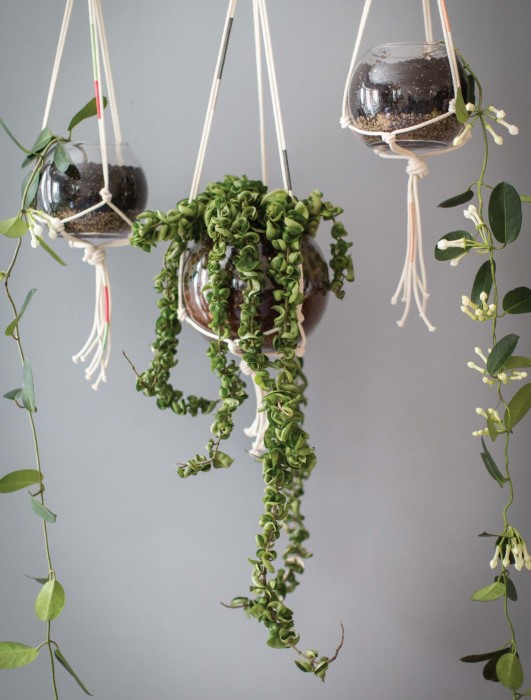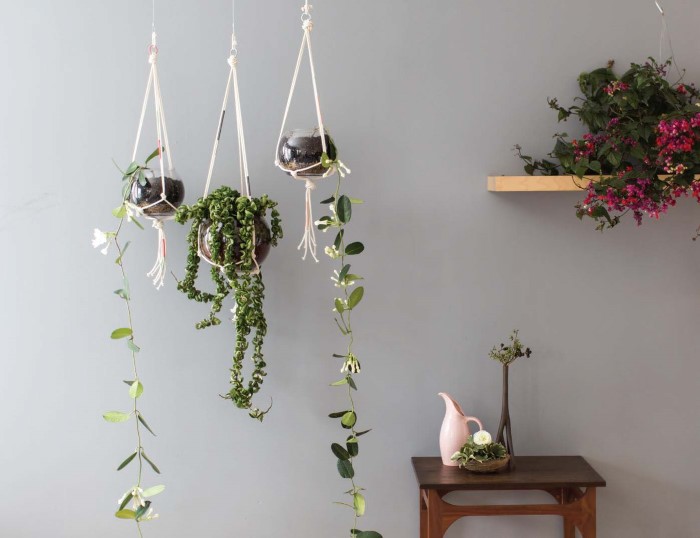Macrame is back! In case you didn’t get the memo about the rebirth of 70’s home crafts like terrariums, hanging plants, and macrame, consider this fair warning. I’ve been seeing plants hung in knotted rope everywhere from cool vegan eateries to upscale designer boutiques, and now that they grace the pages of Tara Heibel and Tassy de Give’s book on creative indoor planting you know it will be showing up everywhere.

Tara and Tassy are the owners behind the stylish and popular Sprout Home stores in Chicago and Brooklyn and now they are the authors of Rooted in Design, which provides readers with the means to create beautiful and long-lasting indoor landscapes. Today they join us to show us how to make modern macramé.

The plant and container are not the only aesthetic considerations. The hanging mechanism itself, such as rope or cord material, contributes to the finished style of the hanging plant. For lightweight vessels that are less than two pounds, use fishing line for a floating effect. Wire cable, which you can purchase by the foot at a hardware store, gives a solid, sleek look to the hanging arrangement. Or, consider using steel chain for an industrial feel. For a more natural approach, we like using leather, yarn, cotton twine, and other materials that can be highly manipulated and tactile. The options are boundless, and each can impact the demeanor of your hanging garden. And who says that it has to be only one string hanging down to support your plants? What if there were multiple cords acting in unison? Yes, we are talking about macrame.

Whether you are living in a small apartment in Brooklyn, a farmhouse in Oklahoma, or a beach house in California, hanging planters with macrame can save on space and add texture to a room or patio. A modern take on macrame deconstructs the shaggy, yellow owls of decades past to one simple element: the knot. There is something so pure and simple about this nostalgic, utilitarian, yet stylish craft. Before its comeback in the 1970s, macrame had nearly become extinct. Currently, macrame is making yet another comeback and we love all of the new, modern takes on this classic craft.

Pictured above is a macrame construction using cotton cord with colored thread wrapped around it to create patches of color that break up the vertical lines of the space. The small pop of color against the natural cotton cord is soft enough to work with any style of decor, from bohemian to modern. The glass vessels are great for showcasing the lines of the macrame. Stephanotis floribunda, with its beautiful waxy, deep green leaves, is the perfect complement to the twist and curves of the wild trailing Hoya plant. The macrame envelops each planting and highlights the natural ease of the plants beautifully.
Materials List
- Three 100” lengths of 3⁄16”-thick cotton cord
- 1” to 11⁄4” brass ring or key chain ring
- Hook or nail affixed to a wall (to hold macramé while you work)
- Scissors
- Colored string
- 8” glass bowl
- Rocks for drainage (we recommend lava rock)
- Potting soil
- Plants suitable for an 8” container (such as Stephanotis and Hoya plants)
- Decorative moss (optional)

step 1 Slide all three cords through the metal ring until the ring is at their midpoint. If you hold the ring up, you’ll have six cords to work with, each 50 inches in length.
step 2 Use all six lengths to tie a knot tightly against the ring. Make the knot as tight as possible by pulling on each cord individually.
step 3 Hang the ring on a hook or nail affixed on a wall. This will allow you to use both of your hands while you work.
step 4 Divide the cords into three groups of two. Tie a simple knot in each pair 18 inches below the ring. You will have three knots that line up horizontally. Make sure each knot is tight.
step 5 Take one string from two adjacent knotted pairs, and tie them together in a knot about 5 inches down from the previous knot.
step 6 Repeat step 5 until all of the bundles are tied together. This creates a zigzag pattern among the cords.
step 7 About 5 or 6 inches below the second set of knots, tie all six lengths together to make one large final knot. Pull each cord individually to ensure that the knot is as tight as possible.
step 8 Use scissors to trim the cords to your desired length.
step 9 Wrap the colored string around individual cords to create 4-inch blocks of color (or any length that you like). Tie it off in a knot and cut any excess string. Now that you’ve completed your macramé hanger, you can begin planting the container.
step 10 Place about 1 inch of lightweight rocks into the bottom of the glass bowl. Fill the bowl with 3 inches of potting soil.
step 11 Remove the plant from its container and massage the roots to loosen the soil. Place the plant into the glass bowl and fill in the sides with potting soil, then pat down the soil firmly. Place decorative moss on top of the soil (optional).
step 12 Place the bowl directly above the lowest knot and pull up the sides of the cords to create a web for it to rest on. Pull any long plant stems through the macramé to ensure the plant is sitting evenly on all sides.

Now run out (or click over) and get a copy of Rooted in Design. You’ll get pages of expert advice for choosing plant varieties and pairing them with unique design ideas. Heibel and DeGive share practical tips honed through hundreds of plant design classes, but most importantly will inspire you to dig in and try their one-of-a-kind garden creations!
Reprinted with permission from Rooted in Design by Tara Heibel and Tassy de Give, copyright (c) 2015. Published by Ten Speed Press, a division of Penguin Random House, Inc. Photography (c) 2015 by Ramsay de Give and Maria Lawson
More Houseplant Projects for You!
- Houseplants as Biofilters: Do Indoor Plants Really Purify the Air?
- Indoor Plant Care: How to Grow Tropical Plants in Geometric Terrariums
- These Aren’t Your Grandma’s Houseplants! Indoor Plant Projects for Modern Day Decor
- Playing with Houseplants for Indoor Garden Therapy
- Liven Up Your Home with Indoor Vertical Wall Planters




Hi, great blog! I’m new to macramé and would really appreciate it if you could let me know where you got the cord used for this project. Buying the cord seems to be stumping me way too much! Thanks a lot :)
Thanks Emma! I think this would do the trick http://amzn.to/1SiyHeR :)
Thanks Stephanie!
100 inches or feet? The link is to 100 feet of cord. Wish I had noticed that before ordering.
Hi Tiffany, for each hanger, it requires three 100″ lengths of cord. So with 100ft (which was the smallest bundle I could find back in the spring) you could make 4 of these hangers. Not bad for just under $7.
Ah, once again, what’s old is new again! I used to macrame big-time back in the 70s when I was a kid – just wish I kept some of those projects. This is a very easy starter project and hopefully, now thanks to YouTube and other online resources, will spark folks to further explore the wonderful world of knots! I’m re-inspired. Thanks, Stephanie!
indeed! Macrame is making a comeback in a big way.
I have a large pot that weighs about 14 pounds without any planting medium. I plan on putting succulents in it. Diameter at center is around 12 inches. I’m thinking I’m going to need nylon rope to hold the weight. Any suggestions? It is going to hang outdoors but not in the full sun. I live in Northern CA where our summer temps can be 90-105.
Hi Patty, when looking for cord, it should give you a measurement of how much weight it can hold. I would ask at your local hardware store. I would love to see a picture when it’s done! Sounds lovely. Have fun!
Thanks for the inspiration! :) I’ve been pondering how to over-winter my tender succulents this year, as my toddler granddaughter will surly uproot anything she can get her adorable little hands on. I am happy to report that the succulents are now hanging safely out of reach, in my kitchen window. And what a lovely spot for them, too!
I’ve just recently discovered your site, Stephanie, and I love love love it! Even added you to my favourites bar ;)
Thank you so much for the kind words, Ruthy! I had a toddler once and I know your struggles! Enjoy your beautiful new winter display.